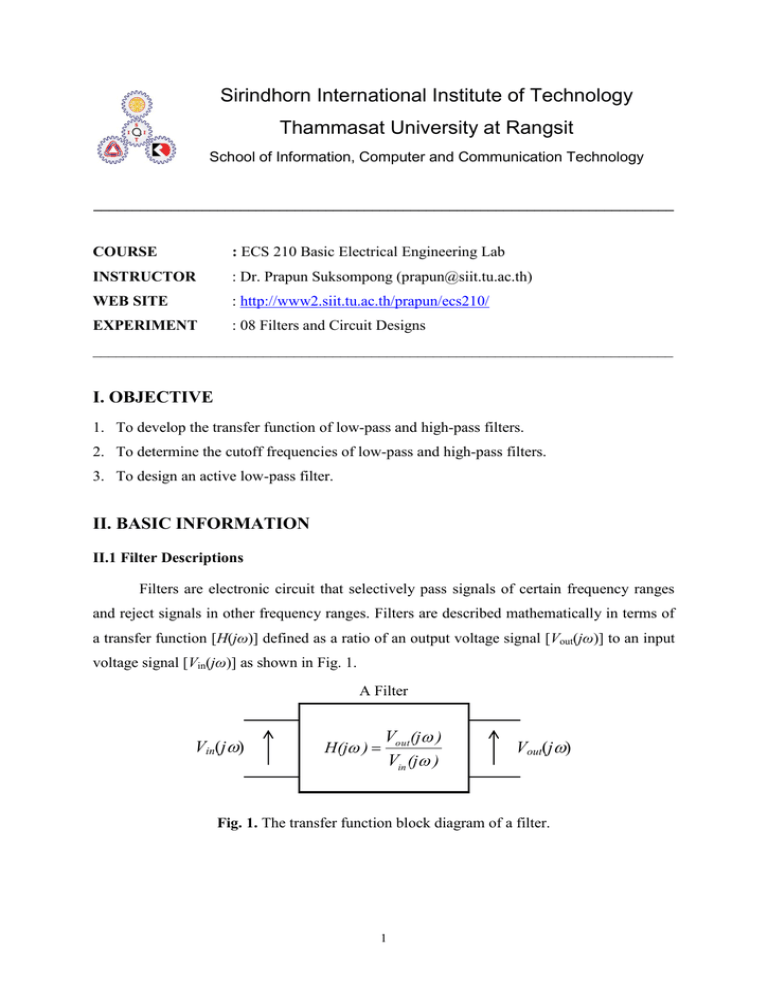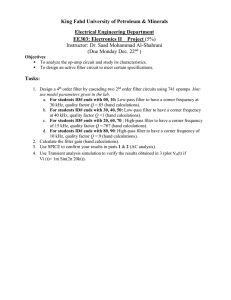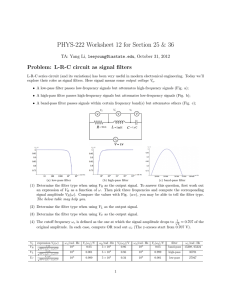Filters and Circuit Design - Sirindhorn International Institute of
advertisement

Sirindhorn International Institute of Technology Thammasat University at Rangsit School of Information, Computer and Communication Technology ___________________________________________________________________________ COURSE : ECS 210 Basic Electrical Engineering Lab INSTRUCTOR : Dr. Prapun Suksompong (prapun@siit.tu.ac.th) WEB SITE : http://www2.siit.tu.ac.th/prapun/ecs210/ EXPERIMENT : 08 Filters and Circuit Designs ___________________________________________________________________________ I. OBJECTIVE 1. To develop the transfer function of low-pass and high-pass filters. 2. To determine the cutoff frequencies of low-pass and high-pass filters. 3. To design an active low-pass filter. II. BASIC INFORMATION II.1 Filter Descriptions Filters are electronic circuit that selectively pass signals of certain frequency ranges and reject signals in other frequency ranges. Filters are described mathematically in terms of a transfer function [H(jω)] defined as a ratio of an output voltage signal [Vout(jω)] to an input voltage signal [Vin(jω)] as shown in Fig. 1. A Filter Vin(j) H(j ) Vout (j ) Vin (j ) Vout(j) Fig. 1. The transfer function block diagram of a filter. 1 The transfer function H(jω) captures magnitude and phase responses of filters at each frequency. Plot of the magnitude response (also called “voltage gain” or “frequency response”) is the indicates the cut-off frequencies and how well the filter can distinguish between signals at different frequencies. The phase response (also called “phase shift”) provides the amount of phase shift introduced in sinusoidal signals as a function of frequency. Both magnitude and phase responses are commonly shown on semi-logarithmic graphs where the horizontal axis is the frequency on a logarithmic scale and the vertical axis show the voltage gain in decibels or the phase shift of the output voltage with respect to the applied input voltage. Filters are used in circuits to remove unwanted frequency components from the signal, to enhance wanted ones, or both. They can be categorized into three major types. A low-pass filter (LPF) allows only low frequency signals to pass through. A high-pass filter (HPF) allows only high frequency signals to pass through. A bandpass filter (BPF) allows signals within a certain frequency range to pass through. Each type of filters can also be classified as passive and active filters based on the use of electronic components. Active filters contain amplifying devices such as transistors and amplifiers in order to increase signal strength while passive filters do not contain any amplifying devices to strengthen the signal. As there are only passive components within a passive filter design the output signal has smaller amplitude than its corresponding input signal, therefore passive filters attenuate the signal and have a gain of less than unity. II.2 Low-Pass (LP) Filter Fig. 2 (a) and (b) show the circuit configurations, transfer functions and cutoff frequencies of both active and passive low-pass filters. It is seen in Fig. 2 (a) that the passive low-pass filter contains only RC components, and consequently the gain is fixed at unity. The active low-pass filter in Fig. 2 (b), however, alternatively comprises of an amplifier with two resistors that set the gain of values R2/R1. 2 R Transfer Function vin vout C H LP , passive( j ) = 1 1 + jRC Cut-off frequency c 1 1 2f c RC (a) A passive low-pass filter. C Transfer Function R2 H LP ,active ( j ) = R1 R2 1 R1 1 + jR2C Cut-off frequency vin vout c 1 1 2f c RC (b) An active low-pass filter Fig. 2. Circuit configurations, transfer functions and cutoff frequencies of passive and active low-pass filters. Fig. 3. Magnitude and phase responses of passive low-pass filter. 3 Fig. 3 shows the magnitude and phase responses of the passive low-pass filter. The frequency at which the filter begins to attenuate signals is called the “cutoff frequency”. At this cutoff frequency, the output voltage is attenuated to 70.7% of the input voltage (or 3dB of the input in Decibels). Note that the cutoff frequency can be expressed as c in radians per second or as fc in Hertz. (Watch out for a factor of 2!) All the frequencies below the cutoff frequency, which is unaltered with little or no attenuation, are considered to be in a passband zone. Other signal frequencies above the cutoff frequency are generally considered to be in the filters stopband zone. As the filter contains a capacitor, the phase angle of the output signal lags behind that of the input and at the -3dB cut-off frequency and is -45o out of phase. II.3 High-Pass (HP) Filter As the name implies, the high-pass filter permits high frequencies to pass from the input through to the output of the filter. Due to the abundance of electric motors and fluorescent lights, 60-Hz noise is the most prevalent unwanted signal. Although many applications exist, one of the most common uses for the high-pass filter is to prevent 60-Hz noise from entering a sensitive electrical or electronic system. Fig. 4 (a) and (b) show the circuit configurations, transfer functions and cutoff frequencies of both passive and active high-pass filters, respectively. It is seen in Fig. 4 (a) that the passive high-pass filter also contains only RC components, but exact opposite to the low- pass filter, as the two components have been interchanged, with the output signal being taken from across the resistor. Fig. 5 shows the magnitude and phase responses of a passive high-pass filter. The high pass filter only passes signals above the cutoff frequency, eliminating any low frequency signals. The magnitude response of the high-pass filter is the exact opposite to the low-pass filter, i.e. the signal is attenuated or damped at low frequencies with the output increasing at +20dB/Decade until the frequency reaches the cutoff frequency. The phase of the output signal leads the input signal and is equal to +45o at the cutoff frequency. The frequency response curve for a high pass filter implies that the filter can pass all signals out to infinity. However in practice, the high-pass filter response does not extend to infinity but is limited by the characteristics of the components used. 4 Transfer Function C H HP , passive( j ) = vin vout jRC 1 + jRC Cut-off frequency R c 1 1 2f c RC (a) A passive high-pass filter. Transfer Function R2 R1 H HP ,active ( j ) = C jR2 C 1 + jR1C Cut-off frequency vin vout 1 2 1 1 1 2 1 2f1 R1C 1 2f 2 R2 C (b) An active high-pass filter Fig. 4. The circuit configurations, transfer function and cutoff frequencies of passive and active high-pass filters. Fig. 5. Magnitude and phase responses of the passive high-pass filter. 5 II.4 Bandpass (BP) Filter The bandpass filter permits a range of frequencies to pass from one stage to another. Many different types of bandpass filters are used throughout electronics. For instance, the typical television receiver uses several stages of filtering to achieve a bandwidth of 6 MHz, while an AM receiver has circuitry which restricts the bandwidth to only 10 kHz. The bandpass filters can be very elaborate depending on the application, Fig. 6 shows the simple passive bandpass filter constructed by combining a low-pass filter and a high-pass filter. High-Pass Filter Low-Pass Filter C1 R2 vin vout C2 R1 Lower cutoff frequency Upper cutoff frequency (Determined by HP filter) (Determined by LP filter) 1 1 1 1 2f1 R1C1 2 1 2 1 2f 2 R2C2 Fig. 6. The circuit configurations, transfer functions and cutoff frequencies of the passive bandpass filters. The bandpass filter has two cutoff frequencies as determined by the cutoff frequencies of the individual low-pass and hig-pass stages. The frequency below which the high-pass filter attenuates the signal is called the lower cutoff frequency f1. The frequency at which the low-pass filter begins to attenuate is called the upper cutoff frequency f2. The difference between the two frequencies f2 - f1 is the bandwidth BW. 6 III. MATERIALS 1. Signal generator (sinusoida1 function generator) 2. Digital Multimeter 3. Dual trace oscilloscope 4. Resistors (1/4-W carbon, 5% tolerance): 330-, and others 5. Capacitors (10% tolerance): 0.047-F, 0.47-F, and others 6. Op-Amp: LM741 Fig. 7. Pin details and configuration of IC 741. IV. PROCEDURES Conceptual Diagram of Experiment Procedures Since there are many types of filters, this lab focuses only on the study and design of some simple and useful filters in parts A, B and C as shown in Fig. 8, involving passive and active low-pass filters and the passive high-pass filter. The passive bandpass filter in part D is optional, but students are highly excouraged to study if time is available. Lab 08: Filters and Circuit Designs High-Pass Filters High-Pass Filters Passive LP Active LP Passive HP Part A Part C Part B Active HP Bandpass Filters Passive BP Part D (Optional) Fig. 8. A conceptual diagram of filter types and experiment parts. 7 Active BP Part A: Passive RC Low-pass Filter IN R = 330 Ω OUT vin= 2sin(ωt) C = 0.47μF vout Fig. 9. The passive low-pass filter. 1. Measure the actual values of R and C in Fig. 9, and record in Table A.1. 2. Connect the passive low-pass filter (LPF) circuit as shown in Fig. 9. 3. Set the input vin from the function generator to be a sinusoidal signal with amplitude of 2V0-P (4.0 Vp-p) and the frequency of 100 Hz. Connect this input vin to the input node IN of the LPF. 4. Connect Channel 1 of the oscilloscope to the input node IN and connect Channel 2 to the output node OUT. 5. Increase the frequency of the signal generator to the frequencies indicated in Table A.1. Use the oscilloscope to measure the amplitude and phase shift of vout (with respect to vin) for each frequency. Record the values in Table A.1. 6. Use your measurements recorded in Table A.1 to calculate the magnitude of the gain as a ratio of the amplitudes vout/vin. Calculate the voltage gain in Decibels as Vout [Av]dB = 20 log Vin Record the calculated voltage gain and measured phase shift for each frequency in Table A.1. 7. Plot the data of Table A.1 on the semi-logaritmic scales of Fig. A.1. Connect the points with the best smooth continuous curve. 8. Find the DC gain and cutoff frequencies in radians and record the calculated cutoff frequency in Table A.2. 8 Part B: Passive RC High-pass Filter IN C = 0.47μF vin= 2sin(ωt) OUT R = 330 Ω vout Fig. 10. The passive high-pass filter. 1. Measure the actual values of R and C of Fig. 10 and record in Table B.1. 2. Connect the passive low-pass filter circuit as shown in Fig. 10. 3. Redo as in steps 3 – 7 of Part A, but record all the values in Table B.1, plot the data of Table B.1 in Fig. B.1, and find the DC gain and cutoff frequencies in Table B.2. Part C: Design of An Active Low-pass Filter 1. Design the “Active Low-Pass Filter”, which has the cut-off frequency = 1 kHz, and the DC gain = 5. 2. Indicates the chosen values of input signal amplitude, power supply voltages, resistors and capacitors in Fig. C.1. Note that the operating power supply range of the OP-AMP no. LM 741 is 5V-15V, i.e. the positive and negative power supplies must not exceed +15V and -15V, respectively. 3. Test for the DC gain by applying the appropriate value of the DC input signal and notice that the DC output signal is 5 times larger than the DC input signal. Draw the DC input and output signals in Fig. C.2 4. Test for the cut-off frequency by applying the sinusoidal input signals at different frequencies. Sketch sinusoidal input and output signals and record the corresponding values in Fig. C.3 – C.5. 9 Part D: Passive RC Bandpass Filter (Optional) IN vin= 2sin(ωt) R2 = 330 Ω C1 = 0.47μF R1 = 330 Ω C2 = 0.047μF OUT vout Fig. 11. The passive bandpass Filter. 1. Measure the actual values of R1, R2, C1 and C2 of Fig. 11, and record these values in Table D.1. 2. Assemble the passive bandpass filter in Figure 11. 3. Redo as in steps 3 – 7 of Part A, but record all the values in Table B.1, plot the data of Table D.1 in Fig. D.1, and find the cutoff frequency for the high-pass stage (1, f1) and the low-pass stage (2, f2) as well as the bandwidth in Table D.2. 10 Table A.1: Voltage gain and phase shift of the passive low-pass filter R = ___________________, C = ________________________ Frequency Amplitude f (Vp-p) Gain vout Phase shift (degrees) Av = Vout/Vin Response Amplitude Phase [Av]dB (Degree) 100 Hz 200 Hz 400 Hz 800 Hz 1 kHz 2 kHz 4 kHz 8 kHz 10 kHz Fig. A.1: Frequency Response of the passive low-pass filter Table A.2: DC Gain and cutoff frequency of the passive low-pass filter Parameters DC Gain Cut-Off Frequency c in rad/s Cut-Off Frequency fc in Hz Calculation Experiments % error TA’s Signature: ________________________ 11 Table B.1: Voltage gain and phase shift of the passive high-pass filter R = ___________________, C = ________________________ Frequency Amplitude f (vp-p) Gain vout Phase shift (degrees) Av = vout/vin Response Amplitude Phase [Av]dB (Degree) 100 Hz 200 Hz 400 Hz 800 Hz 1 kHz 2 kHz 4 kHz 8 kHz 10 kHz Fig. B.1: Frequency response of the passive high-pass filter Table B.2: DC Gain and cutoff frequency of the passive high-pass filter Parameters DC Gain Cut-Off Frequency c in rad/s Cut-Off Frequency fc in Hz Calculation Experiments % error TA’s Signature: ________________________ 12 Fig. C.1: Chosen values of signals and components of the active low-pass filter to be designed for the cut-off frequency = 1 kHz, and the DC gain = 5. C =______ R2 =______ VSS =______ IN R1=______ OUT vin vout VDD =______ TA’s Signature: ________________________ Fig. C.2: Tests for the DC gain. Voltage Chosen Vin (DC) =________________ Vout (DC) =_______________________ DC Gain =________________________ Channel 1: volts/div = _____________ Channel 2: volts/div = _____________ Time/div = ____________ Time 13 Fig. C.3: Tests for the cutoff frequency at f << 1kHz Voltage Chosen amplitude of vin (vp-p) =_____________ Chosen frequency of vin =__________________ Gain =_________________________________ Phase shift =____________________________ Channel 1: volts/div = ____________________ Channel 2: volts/div = ____________________ Time/div = ___________________ Time Fig. C.4: Tests for the cutoff frequency at f = fc = 1kHz Voltage Chosen amplitude of vin (vp-p) =___________ Frequency of vin =______________________ Gain =_______________________________ Phase shift =__________________________ Channel 1: volts/div = __________________ Channel 2: volts/div = __________________ Time/div = _________________ Time Fig. C.5: Tests for the cutoff frequency at f >> fc Voltage Chosen amplitude of vin (vp-p) =___________ Chosen frequency of vin =________________ Gain =_______________________________ Phase shift =__________________________ Channel 1: volts/div = __________________ Channel 2: volts/div = __________________ Time/div = _________________ Time TA’s Signature: ________________________ 14 Table D.1: Voltage gain and phase shift of the passive bandpass filter. (Optional) R1 = _________, R2 = __________,C1 = _________, C2 = ___________ Frequency Amplitude f (vp-p) Gain vout Phase shift (degrees) Av = vout/vin Response Amplitude Phase [Av]dB (Degree) 100 Hz 200 Hz 400 Hz 800 Hz 1 kHz 2 kHz 4 kHz 8 kHz 10 kHz 20 kHz 40 kHz 80 kHz 100 kHz Fig. D.1: Frequency response of the passive bandpass filter. 15 Table D.2: DC Gain and frequencies of the passive bandpass filter (Optional) Parameters DC Gain Frequency 1 in rad/s Frequency f1 in Hz Frequency 2 in rad/s Frequency f2 in Hz Bandwidth in Hz Calculation Experiments % error V. QUESTIONS 1. Figure Q-1 shows the response of ……………filter. Vout Frequency (MHz) Figure Q-1 (a) a low-pass (b) a high-pass (d) a stop-band (e) none of the above (c) a band-pass 2. Briefly explain the major characteristics of the low-pass filter and give some example of applications. 3. Briefly explain the characteristics of the high-pass filter and give some example of applications. 4. Briefly explain the characteristics the bandpass filter and give some example of applications. 16





